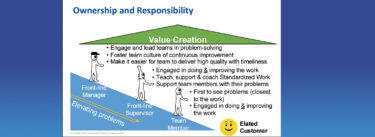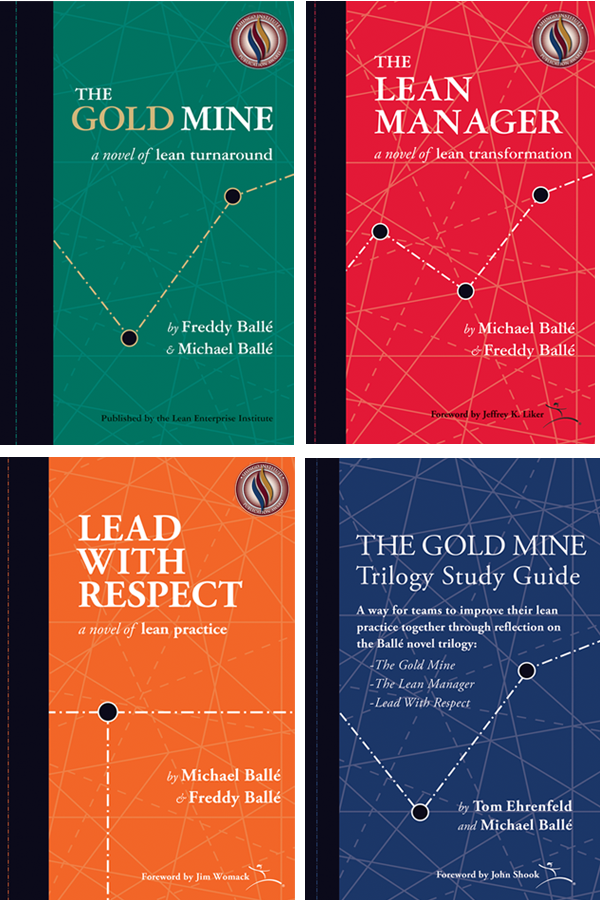Hoshin kanri, a lean approach to planning and deployment, offers a fundamentally different approach to strategy than the conventional top-down approach taught by business schools. Perhaps the most important distinction between hoshin kanri (HK) and traditional “strategy” methods (such as Michael Porter’s competitive advantage model) is that HK involves both setting goals and achieving them. Practicing HK involves planning and execution, in a manner that involves every person in your organization at every level.
In this excerpt from Getting the Right Things Done, author Pascal Dennis argues that HK represents a better approach to strategy because it forces those doing the work to deeply understand the work of the enterprise. Rather than craft an ideal blue-sky strategy based entirely on external factors, HK produces actionable directions based on a deep understanding of customer demand and internal capabilities. No “perfect” objectives based on lofty ideals; HK generates meaningful plans based on deep analysis of the real work of real people solving real problems. Notes Pascal:
“Strategy deployment provides a broad umbrella structure that allows the Plan-Do-Check-Adjust cycle—the scientific method—to flourish. It seeks to balance the benefits of centralized control with the need for autonomy and initiative. Strategy deployment provides for “bottom-up” involvement, tapping into a vast knowledge reservoir and diluting the Dilbert effect.”
And in a related Post, Pascal emphasizes HK’s grounded basis of setting direction. HK is the engine “through which we align, focus, and engage our team members,” he notes, adding that “unlike conventional planning systems, our emphasis is deployment—not selection—and deployment is difficult.”
Enrich Your Organizational Self-Awareness with HK
Lean masters use HK to learn more about their strengths and how to develop them to achieve key organizational goals continuously. “Objectives tied to creating competitive advantage within an industry are the essence of strategy,” says Dave LaHote in his excellent Post on What Strategy Is and What It’s Not. Yes, the hoshin process “can be a powerful tool for helping an organization narrow their focus on a few key objectives that have significant competitive and therefore strategic implications,” he says—while emphasizing that any strategy must link priorities with an understanding of why they are to be pursued.
With hoshin kanri, deploying effective strategy is rooted on internal practices as much as external visions.
“The discussion about how to accomplish the objectives and the establishment of measure and milestones is what engages and aligns the organization,” he says. And so the practice of deploying effective strategy is rooted on internal practices as much as external visions. Deeply understanding what customers want and having a sense of where the market is going are necessary but not remotely sufficient. Tapping your organizational self-awareness to focus on how you will get there is part and parcel of this practice.
That’s why companies tap hoshin as a measure of ongoing organizational vitality. Disciplined hoshin practice provides numerous organizational countermeasures to ineffective strategic planning. Flavio Augusto Picchi enumerates some of these in his Ten Strategy Planning Problems Hoshin Kanri Can Solve Planet Lean article. “Hoshin aligns leadership horizontally and vertically, connecting problem solving and improvement initiatives at different levels of the firm with organizational goals, thus avoiding dispersed efforts,” he writes.
Unlike traditional strategic plans providing episodic direction, Picchi says HK provides ongoing guidance on how plans are to be deployed, focusing everyone on the tangible and daily actions needed to achieve defined objectives. HK also avoids the exclusively “top-down” approach in which top managers communicate marching orders to their teams: “Hoshin combines top-down, bottom-up, and horizontal interactions in a process called catchball.”
And, he says the pull-based nature of hoshin ensures that people working in support areas rather than managers must take accountability for achieving goals: “The CEO encourages directors to take the initiative by establishing a challenging True North and pulls from them as they take charge of the process, and, in turn, pull from their teams and support areas to make sure the actions necessary to deploy the strategy are planned, executed, and results are achieved.”
Break Big Goals Down Into Achievable Subtasks
Jim Womack illustrates the hoshin process in translating a broad strategic target into cascading goals in his Post on The Cascade of Hoshin. Describing hoshin as “the management mechanism necessary to translate high-level plans into sustainable results on the front lines,” Womack drills down into the ways that Toyota has broken down the challenge of responding to Mobility 2.0 (“a ‘once-in-a-century’ disruption caused by the simultaneous emergence of autonomy, alternative energy, shared assets, and hyper-connectivity”) into front-line problems.
Broad strategic hoshin objectives need a companion operational hoshin detailing how to realize these important targets.
Many initiatives at all levels have been designed as experiments to challenge people to learn more about everything from technical aspects of solid-state batteries and hydrogen fuel cells, to understanding the elements of connectivity between vehicles, passengers, and their environment. Hoshin aligns with lean’s emphasis on learning by doing—rather than discovering things through hopeful hypotheses. Many of these experiments will fail, he notes, acknowledging these operational crusades as a necessary cost of moving forward: “the strategic hoshin of ‘address the once-in-a-century-disruption of the automotive industry’ needs a companion operational hoshin of ‘create the financial resources to support the respond-to-disruption hoshin.’”
Indeed, it’s hard to ignore the ways that hoshin reinforces underlying lean principles. It certainly compels you to sort through your problems, and to in fact develop an operational awareness for your work. Mark Reich explains this dynamic in two articles: Personal PDCA and How I Learned It, and Jishuken: The Power of Self-Learning.
Practice Hoshin to Learn More–About You Need to Learn
Mark draws from his experience at Toyota to demonstrate how hoshin “forces you to consider deeply how you can make the work better for others and this pushes you to understand your own capabilities (or lack thereof) to accomplish such a goal,” he says. He was at one point frustrated with a challenging problem he was asked to tackle, and failed to get a satisfying answer from his boss’s in response to the question of, “What’s the purpose of Jishuken (or self-study)?” It took a while for Mark to finally hear a koan-like response from another veteran: “The purpose of jishuken is to do more jishuken.”
Indeed, this reflective purpose can be found in many essential lean approaches. In fact, the more that one asks the question of what is hoshin kanri, the more one must dig into a deeper question: what is strategy in the first place? This query is deeply embedded in Kanban as a Learning Strategy by Michael Balle, Jacques Chaizes, Orry Fiume, and Dan Jones. The authors address this basic question up powerfully in the following passage:
“The dazzling success of lean companies (Toyota being the exemplar) provides a powerful alternative to the notion of strategy consisting of having the best plans and greatest bargaining leverage. Toyota’s success might best be attributed to its lean strategy, a dynamic, agile, and learning-based approach that can be summarized as: understand your challenges, your core practical problems, train your officers to do so and know how to respond, trust their initiatives and then reflect on what happened and learn fast. Traditional strategy is about optimizing the situation as we see it (assuming perfect knowledge and the assumption that nothing will change quickly); the other is centered on creating a dynamic of trained, autonomous people that can align spontaneously on a shared intent. Facing your challenges, responding faster with all your people, studying your response and learning to do things in new ways together is the lean strategy needed to face the disruptions of the twenty-first century.”
Executing Strategy
Connecting Hoshin to Daily Management and A3.






